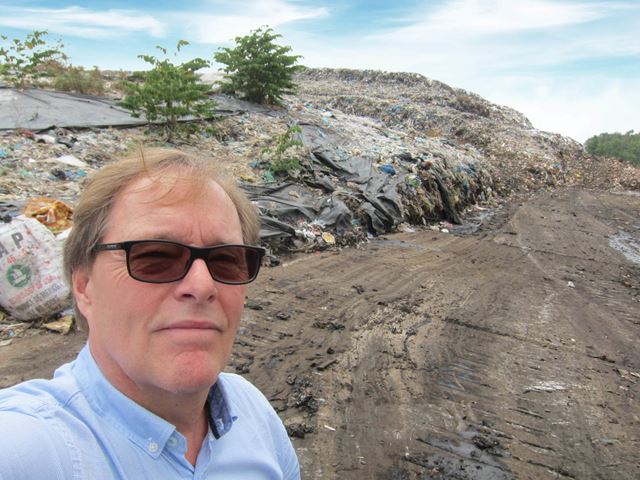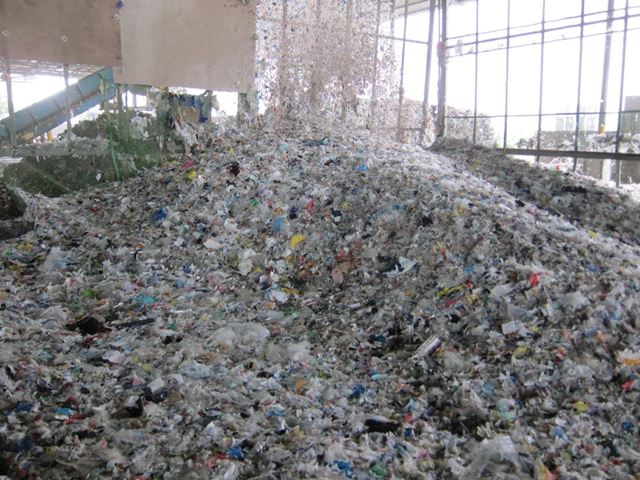Since the 1950s, human beings have generated an estimated 79 million tonnes of plastic waste – every year. However, only nine percent of this waste has been recycled and 12 percent burnt in incinerators. The remaining 79 percent has been dumped, and much of it has ended up in the oceans.
Most of the plastic that reaches the oceans is non-recyclable and, according to recent studies, even if we continue to develop effective waste collection and recycling systems, there will still be large volumes of plastics that cannot be recycled.
Multiple benefits of local waste management
A pilot project recently completed by SINTEF in Vietnam has concluded that local co-processing of non-recyclable plastic waste as a fuel-substitute in cement kilns is a feasible alternative, both environmental and technically.
The tests carried out to demonstrate that not only are the emissions of the environmental toxins called dioxins not increased if plastic waste is used as a supplementary fuel, but that they also meet the strictest limitit values for pollutant emissions.
“An approach such as this will significantly boost plastic waste treatment capacities at local level”, says Chief Scientist Dr. Kåre Helge Karstensen at SINTEF, who has been heading the project. “It will also save on large volumes of coal and reduce the volumes of plastics and microplastics being discharged into the East and South China Seas”, he says.

Using plastic waste as an alternative energy source to coal will prevent the accumulation of mountains of plastic like this. Less plastic will then be broken down to constitute a constant source of microplastic discharges to the oceans. SINTEF Chief Scientist Kåre Helge Karstensen (pictured here) wants to do something about it.
Breaking the cycle
According to international studies, Vietnam is responsible for some of the highest levels of plastic discharge to the world’s oceans. The combination of an elongated coastline, a growing use of plastics, and an inadequate waste management infrastructure all mean that the country discharges between 280.000 and 73.000 tonnes of plastic waste into the oceans every year.
“The replacement of some of the coal with non-recyclable plastics offers a win-win opportunity. It will prevent the plastics from ending up in the oceans, reduce the need for large volumes of coal, and will indirectly cut greenhouse gas emissions because there will be less need to construct new incineration plants and open new landfill sites”
Lee & Man is the largest paper manufacturer in Vietnam, generating about 150 tonnes of waste every day, most of which is plastic. This waste is regarded as non-recyclable and is currently sent to landfills.
Facts about the OPTOCE project
The OPTOCE project (Ocean Plastic Turned into an Opportunity in Circular Economy) is a regional initiative developed by SINTEF and funded by the Norwegian Agency for Development Cooperation (Norad). The project is part of a Norwegian foreign aid programme launched in 2018, targeted at preventing marine pollution and microplastics in particular. The programme is aimed at contributing towards achieving many of the UN’s Sustainable Development Goals, including Target 14.1, which states that by 2025 the world shall have prevented and significantly reduced marine pollution of all kinds.
The aim of the OPTOCE project is to demonstrate the feasibility of reducing plastic waste discharges to the oceans by boosting waste management capacity in selected Asian countries participating in the project. Non-recyclable plastic waste from sources such as landfill sites, rivers and industrial polluters will be used as fuel in cement production. This is a guiding principle of the circular economy – the use of waste from one process as a raw material in another. It will reduce coal consumption and prevent plastic waste from ending up in the oceans.
The project is looking to implement pilot demonstrations in five Asian countries that exhibit a variety of local levels of pollution and other circumstances. These countries have some of the largest rivers in the world and face major challenges associated with plastic pollution. China, India, Thailand, Vietnam and Myanmar are currently participating in the project.
Non-recyclable plastic waste will be recovered for use as an energy source and will replace coal in local energy-intensive industrial plants. Recyclable components will be sent to recycling facilities. Experiences will be shared in a regional forum that will serve to demonstrate the potential of the approach to other countries.
A further aim of the OPTOCE project is to promote the involvement of central government, local authorities, private industry and sector organisations, international organisations, universities and NGOs. The objective of the regional forum is to increase awareness and develop capacity in the effective management of non-recyclable plastic waste.
So far, the results have demonstrated that the cement industry in the participating countries may be able to utilise all non-recyclable plastic waste – and thus prevent it from ending up in the rivers and oceans.
However, the plastic waste dumped in landfill sites will gradually break down and be released into groundwater systems and rivers, providing a continuous source of microplastics to the oceans.
In order to break this cycle, researchers working on the OPTOCE project (Ocean Plastic Turned into an Opportunity in Circular Economy) are conducting a full-scale pilot study. Their aim is to explore the possibility of recovering energy and resources from non-recyclable plastic waste for use in a local cement factory, and in doing so replacing the need to use coal and other raw materials.
“More than 200 tonnes of plastic waste were transported to the cement factory, where they were sun-dried, homogenised and fed into a calcinare as an alternative fuel”, says Dr. Karstensen. “We also tested footwear waste from a local shoe factory”, he says.
No increase in emissions
The four-day test involves sampling of emissions by an independent company in order to find out whether the co-processing of plastic waste has a negative impact on emissions, the production process, or product quality. Co-processing involves the use of waste as a raw material or energy source in industrial processes as a substitute for natural mineral resources and fossil fuels, such as coal.
Gas emissions were analysed at an accredited laboratory for normal emissions to the atmosphere, trace organics such as dioxins, acidic exhaust gases and trace metals.
“All emissions were in compliance with existing limit values. Emissions were not increased, nor were other negative effects identified as a result of co-processing of the plastic waste”, says Karstensen.
A single factory can save a minimum of 10,000 tonnes of coal every year
The first day of the pilot involved a baseline study in which only coal was used as a fuel. During the next three days a mixture of alternative fuel, plastics and coal were fed into the cement kiln in varying proportions. On the final day, only plastic waste and coal were used.
A total of 225 tonnes of plastic waste was co-processed during the pilot study in December 2021, saving about 165 tonnes of coal and reducing CO2 emissions by about. 400 tonnes (assuming that the combustion of 1 kg coal produces about 2.42 kg of carbon dioxide).
These results indicate that we can expect the cement factory in Hon Chong alone to co-process about 17,000 tonnes of paper recycling waste and about 50,000 tonnes of footwear waste annually. This means that from just one factory it will be possible to treat of about 10,000 tonnes of non-recyclable plastic waste and save about 10,000 tonnes of coal every year.

Used paper contains large amounts of non-recyclable plastic waste. This photo is taken from Vietnam’s largest paper factory in Can Tho, which also recycles paper. Photo: Kåre Helge Karstensen/SINTEF
“We’ve been monitoring the project for some time and it clearly demonstrates the enormous potential that Vietnam has to reduce its plastic waste discharge to rivers and the oceans, and to cut its greenhouse gas emissions from energy-intensive industries”, says counsellor Jan W. Grythe at the Norwegian Embassy in Vietnam.
“It is also important, not least because of the country’s ambitious commitments made during COP26 to achieve zero emissions by 2050 and to phase-out coal from the energy mix”, he emphasises.
A win-win opportunity
Sadly, more than five billion tonnes of plastic are currently sitting in landfill and other dump-sites or polluting natural habitats across the world. This is because only a small proportion of our plastics can be recycled and may be because some of the plastic has already been recycled several times, or because it contains additives that make it unsuitable for recycling.

The Mekong river is the world’s tenth largest in terms of water discharge, with a catchment area extending over 810,000 square kilometres. Large volumes of plastic waste are carried in the river on their way to the ocean. Photo: Kåre Helge Karstensen/SINTEF
“This non-recyclable plastic waste will gradually break down and be released into our groundwater systems and rivers”, says Karstensen. “In this way, it accumulates and constitutes a continuous supply of microplastics to the oceans for the foreseeable future”, he says.
The countries participating in the OPTOCE project have a combined population of three billion people, half of whom live along the coastlines. They produce about 79 million tonnes of plastic waste annually and are among the biggest consumers of plastics in the world. As a result, they exhibit some of the highest levels of discharge to the oceans.
These countries all have one thing in common – inadequate plastic waste management and treatment capacities.
On the other hand, they also produce about three quarters of the world’s cement, steel and electrical power, all of which takes place in tens of thousands of plants that burn massive volumes of coal and thus contribute to a major proportion of the world’s CO2 emissions.
“The replacement of some of this coal with non-recyclable plastics offers a win-win opportunity”, explains Karstensen. “It will prevent the plastics from ending up in the oceans, reduce the need for large volumes of coal, and will indirectly cut greenhouse gas emissions because there will be less need to construct new incineration plants and open new landfill sites”, he says.
Facts about plastics in the oceans
Every minute, at least 15 tonnes of plastics are being discharged into the oceans, and this figure is increasing year on year. This means that a total of eight million tonnes of plastic waste end up in the oceans every year. And this does not include the more than five billion tonnes of plastics that are being accumulated inappropriately across the entire planet.
Plastic pollution is one of the world’s fastest growing environmental crises. It represents a problem for the natural world and the climate and is a hazard to public health. Researchers have only recently demonstrated that microplastics can be traced in human bloodstreams, and the consequences of this are very worrying.
The main reason for this pollution is that many of the countries that discharge the largest volumes of plastics to the oceans have either very poor waste management systems, or no such systems at all. More than a third of the world’s plastic waste is not directed to a collection system, and only nine percent is recycled.
Another reason for plastic pollution is that the use of disposable plastic is very high in many countries, and this generates enormous volumes of unnecessary plastic waste.
Plastics represent only ten percent of the world’s total volume of waste, but nevertheless account for the majority of marine pollution.
It is estimated that the volume of plastics in the oceans will increase by between 23 and 37 million tonnes by 2040 unless immediate action is taken.
(Source: WWF)
Cost-effective, resource-effective and the most environmentally friendly
Cement production requires massive volumes of coal and other raw materials. However, all of these components can be substituted, either entirely or in part, by waste that contains energy and/or inorganic components. The substitution process is normally called co-processing.
This approach has been shown to be cost-effective, resource-effective and environmentally friendly when compared to combustion in an incinerator. The energy efficiency is much higher than in modern incinerators that generate energy from waste. Nor are any residual products generated, compared with about 30 percent by volume in a traditional incinerator.
As well as waste from paper manufacturing plants, the researchers are looking into the feasibility of co-processing non-recyclable plastics taken from large rivers, landfill sites, industrial plants and cities in local cement plants.


